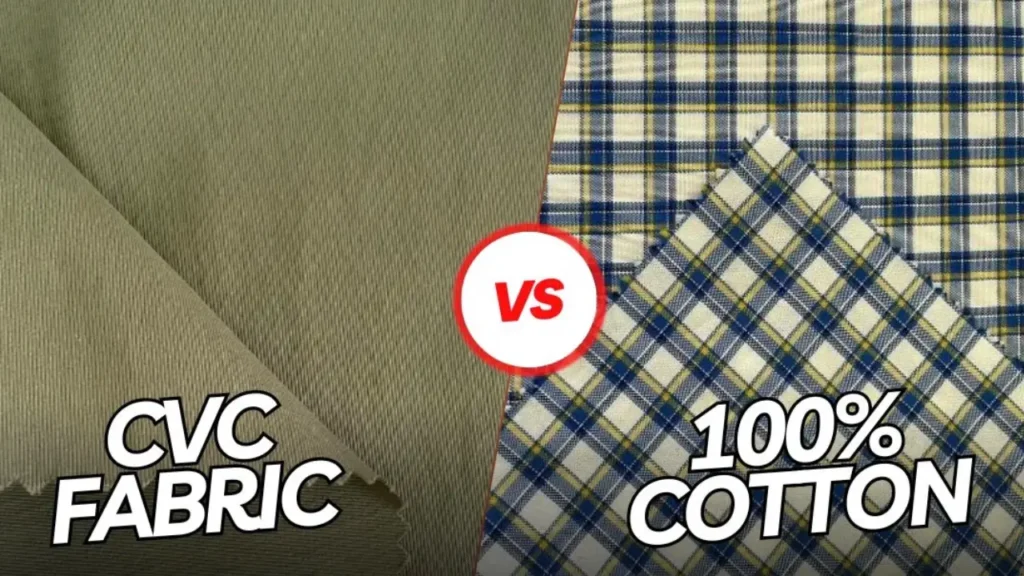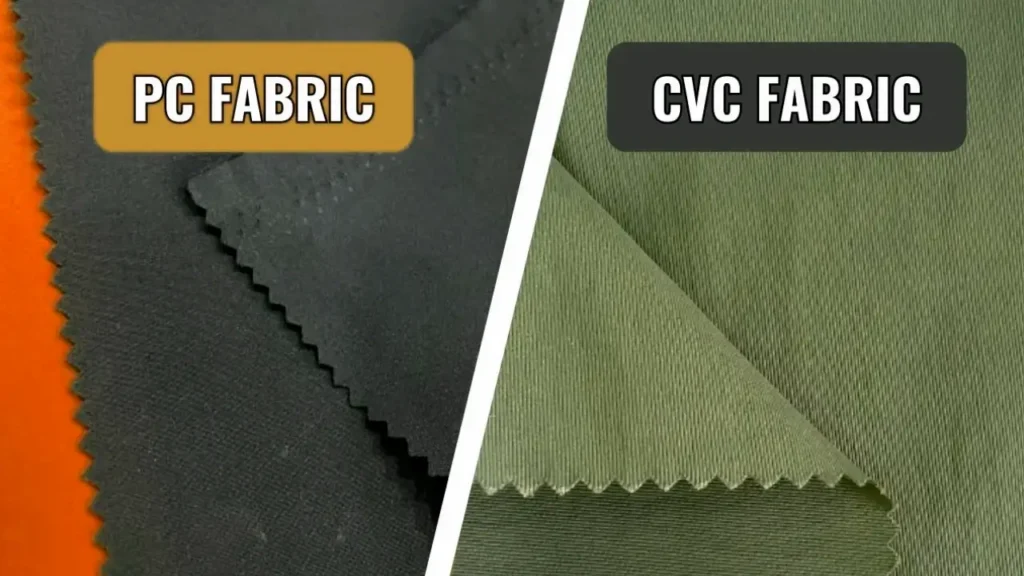CVC (Chief Value Cotton) fabric is a popular textile blend that cleverly combines the desirable properties of two key fibers: cotton and polyester. By weaving together the natural comfort and breathability of cotton with the enhanced durability and wrinkle resistance of polyester, CVC fabric offers a balanced and often more cost-effective solution for a wide range of applications. This innovative blend seeks to provide the best of both worlds in the textile industry.
This blog post will delve into the specifics of CVC fabric, exploring its typical composition and the unique characteristics that arise from this fiber combination. We will also highlight the key benefits that make CVC fabric a favored choice for various end uses, from everyday apparel to more demanding applications. Understanding the advantages of CVC fabric can help you make informed decisions when selecting textiles for your specific needs or product lines.
What Is CVC Fabric
CVC fabric, short for Chief Value Cotton, is a textile blend primarily composed of cotton and polyester fibers, with cotton making up the majority percentage (typically 50% or more). This combination aims to leverage the desirable properties of both materials, creating a fabric that offers a balance of comfort and durability. The specific ratio of cotton to polyester can vary, influencing the final characteristics of the fabric.
The main goal of blending cotton with polyester in CVC fabric is to enhance the overall performance and longevity of the textile compared to 100% cotton. Polyester adds strength, wrinkle resistance, and reduces shrinkage, while the higher percentage of cotton ensures a soft and breathable feel against the skin. This makes CVC fabric a popular choice for a wide range of applications where both comfort and resilience are important.
CVC Fabric Content
CVC (Chief Value Cotton) fabric is a strategic blend of two of the most widely used textile fibers: cotton and polyester. The beauty of CVC lies in its intentional ratio, prioritizing the natural comfort of cotton while strategically incorporating the performance benefits of polyester. This careful combination aims to create a fabric that offers the best of both worlds, making it a versatile choice for numerous applications.
- Cotton (Majority): CVC fabric is defined by having a higher percentage of cotton compared to polyester. This typically ranges from 50% up to 80% or even more. The cotton provides softness, breathability, and good absorbency, making the fabric comfortable against the skin. The higher the cotton content, the more these natural characteristics will be prominent in the final fabric.
- Polyester (Minority): Polyester is the other key component in CVC fabric, usually making up the remaining percentage. Its inclusion enhances the fabric’s durability, strength, and resistance to wrinkles and shrinkage. Polyester also contributes to better color retention, ensuring the fabric’s vibrancy lasts longer through washes and wear. The specific amount of polyester is adjusted to balance these benefits with the natural comfort of cotton.
While cotton and polyester are the primary components, in some variations, you might find small amounts of other fibers blended in to achieve specific properties like stretch. However, the core definition of CVC fabric revolves around a cotton-dominant blend with polyester.
CVC Fabric vs 100 Cotton

When choosing between fabrics, understanding the fundamental differences between CVC (Chief Value Cotton) and 100% cotton is essential. Both are popular choices for apparel and textiles, but their unique compositions lead to distinct characteristics in terms of comfort, durability, and care. This comparison will delve into the key aspects of each fabric, providing you with the knowledge to make the best decision for your specific needs.
Fiber Composition
CVC fabric is a blend where cotton is the dominant fiber, typically making up 50% or more of the fabric content, with the remaining portion being polyester. This blend aims to combine the natural comfort and breathability of cotton with the enhanced durability and wrinkle resistance of polyester. The specific ratio can vary, influencing the final properties of the fabric, but cotton always holds the “chief value.”
100% cotton fabric, as the name suggests, is made entirely from cotton fibers. This natural fiber is known for its softness, excellent breathability, and good absorbency, making it a comfortable choice for clothing and other applications where skin contact is involved. Different weaves and finishes can result in a wide variety of textures and weights in 100% cotton fabrics.
Comfort and Breathability
100% cotton is generally considered superior in terms of breathability and softness against the skin due to its natural fiber structure. It allows for good air circulation and moisture absorption, keeping the wearer cool and dry. This makes it an ideal choice for warm climates and for individuals with sensitive skin.
CVC fabric, while retaining a significant degree of cotton’s comfort and breathability due to its higher cotton content, may not feel quite as soft or breathe as well as 100% cotton, especially in blends with a lower percentage of cotton. However, it still offers a good level of comfort that is often preferred over 100% polyester fabrics.
Durability and Wrinkle Resistance
CVC fabric benefits from the inclusion of polyester, which significantly enhances its durability and resistance to wear and tear compared to 100% cotton. Polyester fibers are stronger and less prone to abrasion, making CVC a good choice for items that require longevity, such as workwear or frequently washed garments. Additionally, the polyester content helps CVC fabric resist wrinkling, often requiring less ironing than 100% cotton.
100% cotton, while a strong natural fiber, is generally less durable than blends containing polyester. It is also more prone to wrinkling and may require regular ironing to maintain a crisp appearance. Over time, pure cotton fabrics can show signs of wear more readily than CVC blends.
Shrinkage and Color Retention
CVC fabric tends to shrink less compared to 100% cotton due to the dimensional stability of polyester fibers. This is a significant advantage for maintaining the garment’s original size and fit after washing. Additionally, polyester helps the fabric retain color vibrancy for a longer time, resisting fading through repeated washes.
100% cotton fabrics are more susceptible to shrinkage, especially during the first few washes. They may also experience color fading over time, particularly if not properly cared for. Preshrinking treatments can mitigate some of the shrinkage, but color retention may still be less robust than in CVC blends.
Cost-Effectiveness
CVC fabric is often more cost-effective to produce than 100% cotton, especially when the cotton used is of a higher quality. The blending with polyester helps to reduce the overall cost of the raw materials. This can translate to more affordable garments and textiles for consumers.
100% cotton fabrics, particularly those made from premium cotton varieties like organic or long-staple cotton, can be more expensive due to the higher cost of the raw material and the processing involved in producing pure cotton yarns.
| Feature | CVC Fabric | 100% Cotton |
| Fiber Composition | Cotton (50%+) blended with Polyester | 100% Cotton |
| Comfort | Good, close to 100% cotton | Excellent, very soft and comfortable |
| Breathability | Good | Excellent |
| Durability | More durable due to polyester | Moderate |
| Wrinkle Resistance | Better due to polyester | Lower, prone to wrinkling |
| Shrinkage | Less shrinkage | More prone to shrinkage |
| Color Retention | Better color retention | Can fade more over time |
| Cost | Generally more cost-effective | Can be more expensive |
| Common Uses | T-shirts, workwear, everyday apparel | All types of clothing, bedding, towels |
Difference Between PC and CVC Fabric

Here’s a comparison between PC (Polyester Cotton) fabric and CVC (Chief Value Cotton) fabric:
Fiber Composition
PC fabric, also known as polycotton or TC (Tetron Cotton), is a blend of polyester and cotton where polyester is the dominant fiber, typically making up more than 50% of the composition (e.g., 65% polyester, 35% cotton, or 80% polyester, 20% cotton). The higher polyester content is chosen to maximize the synthetic fiber’s strength, durability, and wrinkle-resistant properties.
CVC fabric, on the other hand, is also a blend of polyester and cotton, but with cotton as the dominant fiber, making up 50% or more of the blend (e.g., 60% cotton, 40% polyester, or 80% cotton, 20% polyester). The higher cotton content aims to prioritize the natural fiber’s softness, breathability, and comfort against the skin.
Comfort and Breathability
PC fabric, with its higher polyester content, tends to be less breathable and can feel less soft against the skin compared to CVC or 100% cotton. Polyester is a synthetic fiber that doesn’t absorb moisture as well as cotton, potentially leading to a less comfortable feel in warm or humid conditions. However, it can be engineered to have some wicking properties.
CVC fabric offers better breathability and a softer feel due to its higher percentage of cotton. The cotton fibers allow for better air circulation and moisture absorption, providing more comfort, especially for everyday wear and in warmer climates. The level of comfort will depend on the specific cotton-to-polyester ratio, with higher cotton percentages feeling more like pure cotton.
Durability and Wrinkle Resistance
PC fabric excels in durability and wrinkle resistance due to the dominant polyester content. Polyester fibers are strong, resistant to abrasion, and less prone to wrinkling, making PC fabrics ideal for workwear, items requiring frequent washing, and situations where a crisp appearance with minimal ironing is desired.
CVC fabric is less durable and more prone to wrinkling compared to PC fabric because of its higher cotton content. While the added polyester still offers some improvement in these areas compared to 100% cotton, it doesn’t provide the same level of resilience as a polyester-dominant blend.
Shrinkage and Color Retention
PC fabric exhibits minimal shrinkage due to the inherent stability of polyester fibers. It also tends to have excellent color retention, resisting fading through repeated washing and exposure to sunlight. This helps the fabric maintain its original size and vibrancy over time.
CVC fabric will generally experience less shrinkage than 100% cotton due to the presence of polyester. However, it may shrink slightly more than PC fabric due to its higher cotton content. Color retention is also good but might not be as robust as in PC fabrics with a higher proportion of synthetic fibers.
Cost-Effectiveness
PC fabric is often more cost-effective to produce than CVC fabric, especially when higher quality cotton is used in the CVC blend. Polyester is generally a less expensive fiber than good quality cotton, making polyester-dominant blends more economical for large-scale production.
CVC fabric tends to be slightly more expensive than PC fabric when the cotton content is significantly higher, reflecting the higher cost of cotton compared to polyester. However, the price difference can vary depending on the quality of the cotton used.
Comparison about the differences between PC fabric and CVC
| Feature | PC Fabric (Polyester Dominant) | CVC Fabric (Cotton Dominant) |
| Fiber Composition | Polyester (50%+) blended with Cotton | Cotton (50%+) blended with Polyester |
| Comfort | Less breathable, can feel less soft | More breathable, softer feel |
| Breathability | Lower | Higher |
| Durability | Higher | Moderate |
| Wrinkle Resistance | Better | Lower |
| Shrinkage | Minimal | Less than 100% cotton, more than PC |
| Color Retention | Excellent | Good |
| Cost | Generally more cost-effective | Can be slightly more expensive |
| Common Uses | Workwear, durable garments, easy-care items | Everyday wear, t-shirts, comfort-focused items |
Conclusion
In conclusion, CVC fabric offers a compelling blend of the desirable properties of both cotton and polyester. By prioritizing cotton content, it retains a significant degree of breathability and softness, ensuring comfort against the skin. The inclusion of polyester enhances the fabric’s durability, wrinkle resistance, and often its affordability, making it a practical choice for a wide range of applications.
The versatility of CVC fabric lies in its ability to be tailored with varying ratios of cotton to polyester, allowing manufacturers to fine-tune the fabric’s characteristics to meet specific needs. This adaptability makes it a popular option for apparel, workwear, and home textiles, where a balance of comfort and performance is essential. Understanding the benefits of CVC fabric empowers informed decisions for both creators and consumers.
Looking for a reliable source of high-quality CVC fabric for your manufacturing needs? At Fanda Fabrics, we offer a diverse selection of CVC blends, customizable to your specific requirements for comfort, durability, and cost-effectiveness. Contact us today to explore our wholesale fabric options and elevate your product line!
